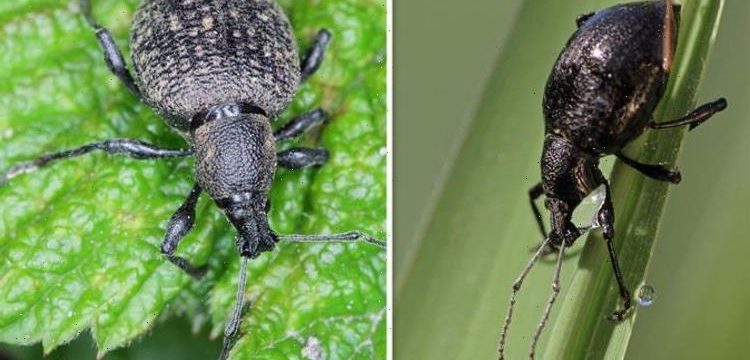This Morning: Alice Beer shares tips for removing pests
We use your sign-up to provide content in ways you’ve consented to and to improve our understanding of you. This may include adverts from us and 3rd parties based on our understanding. You can unsubscribe at any time. More info
Vine weevils have been the bane of many gardener’s progress for years. These tiny pests issue two-pronged attacks on foliage and the roots of many plants, particularly those in containers. Express.co.uk has compiled a helpful guide to assist you in banishing them from your home, garden and greenhouse.
Vine weevils are insects which feed on a range of ornamental plants and fruits, especially those grown in containers.
Adult bugs eat leaves and the grubs eat roots.
These beetles feature both indoors and outdoors, and they can be especially damaging to plants grown in containers.
Plants growing in pots and containers are most likely to be severely damaged by grubs.
Plants growing in the open ground are less likely to be damaged, although heavy infestation of grubs can occur on strawberries, polyanthus and young yew plants.


Adult beetles often feed on the foliage of many herbaceous plants and shrubs.
Adults rarely cause enough damage to impact the vigour of plants.
These insects unleash terrible devastation on plants making suddenly otherwise healthy-looking plants wilt and collapse.
The real damage to these plants is the underground grub, which can prove damaging.

How to get rid of vine weevils
The first step in getting rid of vine weevils is to identify these plants.
Baby vine weevils grow from little eggs laid in the plant’s roots which are very difficult to see.
They hatch into grubs with cream coloured bodies and brown heads.
These bugs munch away at the root system until they are either caught or the plant first yellows.
It will then wilt and collapse through lack of sustenance.
Adult vine weevils damage plants by eating irregular notches from the edges of leaves.
The larvae or grubs munch at the root system which slows the growth of the plant before the leaves wilt and the plant collapses through lack of nutrients.
Damage will be most evident from autumn to spring.
DON’T MISS
Rats the ‘size of cats’ torment residents for ‘seven years’ [INSIGHT]
How to get rid of moths – Top tips for a pest free home [EXPLAINER]
Gardening expert shares natural method for ‘controlling pests’ [ANALYSIS]

You can remove adult vine weevils physically by collect them at night by torchlight, while they are feeding.
To remove these bugs, you should place a newspaper, tray or an unturned umbrella underneath the plant and shake the plant to dislodge the flightless beetles.
You should then pick up vine weevils, squash them and then bin them.
Specially formulated vine weevil chemical controls can also be used on ornamental plants in pots or containers.
Spray the plants with a systematic and contact insecticide at dusk on mild evenings.

To get rid of grubs, you should try to get rid of them by introducing pathogenic vine weevil nematodes as a biological control.
Steinernema kraussei are little parasitic worms which will do no harm to the plant but which will kill the vine weevil larvae.
As with most biological controls the conditions need to be absolutely right for the treatment to work.
They are best watered into lighter, moist soil at temperatures above 5C in late summer, before the grubs have grown large enough to cause serious damage.
Top tips to deter vine weevils
- Encouraging wildlife such as toads and birds will help to predate the beetles and their larvae.
- Check plants for signs of vine weevils before you bring them into your greenhouse or a conservatory.
- Create a barrier around your pots such as with parcel tape smeared with non-drying insect glue.
- Keep checking your plants for signs of vine weevils.
Source: Read Full Article
